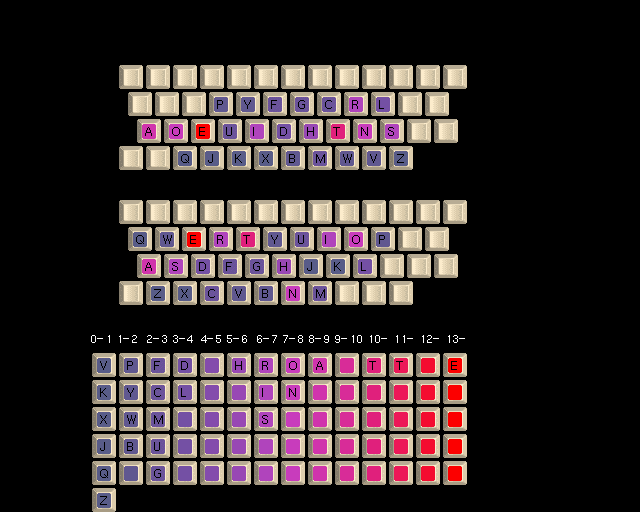This is my spiel about the Dvorak typewriter keyboard layout. This document consists of the following sections:
I was certainly surprised when I found out that the ubiquitous QWERTY keyboard layout that you see on pretty much every computer and typewriter keyboard was designed specifically to slow typists down. The reason for this apparent insanity is, basically, that the earliest typewriter mechanisms were very slow, and tended to jam when typists attempted higher speeds. It didn’t take long for physical typewriter technology to improve, but the QWERTY layout had become ensconced.
In the 1930’s, August Dvorak (a distant cousin of composer Antonin Dvorak, and a professor at the University of Washington) devised a new arrangement of all the alphabetic and some of the punctuation keys. This new arrangement was based on how frequently the characters were used in the English language. The predominant features of the Dvorak layout are:
This diagram may help illustrate the layout and its benefits (especially when I fix it up to make it clearer):

Initially, the cost of refitting typewriters to enable the Dvorak layout was prohibitive, though this changed somewhat with the introduction of golf-ball and daisy-wheel typewriters, since these could be converted as easily as changing the typeface. Today, however, few people rely on physical typewriters any more, using instead digital computers. On all the popular varieties of computer, switching from one keymap to another can be done in software in a matter of seconds (you don’t need to buy a new keyboard), and the only cost of switching to Dvorak is the time it takes to learn the layout. Learning to type Dvorak rather than QWERTY in the first place would do away with this cost difference altogether.
Some facts and figures (bear in mind that these assume typical verbal English as the typing content):
I had been using QWERTY for around 8 years before I made the change to Dvorak, and while an 8-year habit takes a little getting over, I found the change to be totally worthwhile. In spite of having to relearn how to type, I could type faster and more comfortably in Dvorak after two years than I could in QWERTY after six. Dvorak is also extremely conducive to touch-typing, so you don’t actually need to buy a new keyboard or relabel your existing one (although I would recommend using typing tutor software during the initial learning stages—learning the layout ‘blind’ is a bit tricky!)
On the rare occasions that I am forced to type QWERTY, it really is painfully apparent how much more work you have to do—many commonly-used letters are simply not where they should be. I can still type QWERTY today, about as well as I ever could, but I find it kind of demeaning and I try to avoid it.
Don’t put up with this QWERTY madness any more—give Dvorak a try, stick with it, and you should find that typing becomes a more pleasant and productive experience.
For further information about the Dvorak layout, software, and related stuff, check out the following links:
For another “things really could be better if only people would change” issue, have a look at my spiel on the ANSI/ISO date format.
This page has been accessed 94 76 76 times, apparently.
This document last modified and © 2001-09-17 11:45:39 NZST